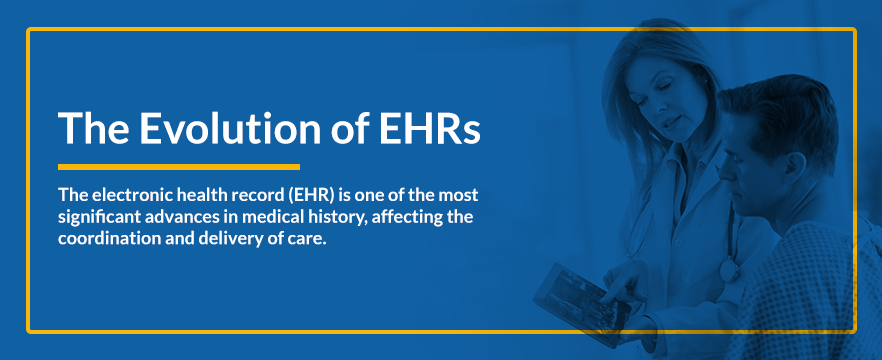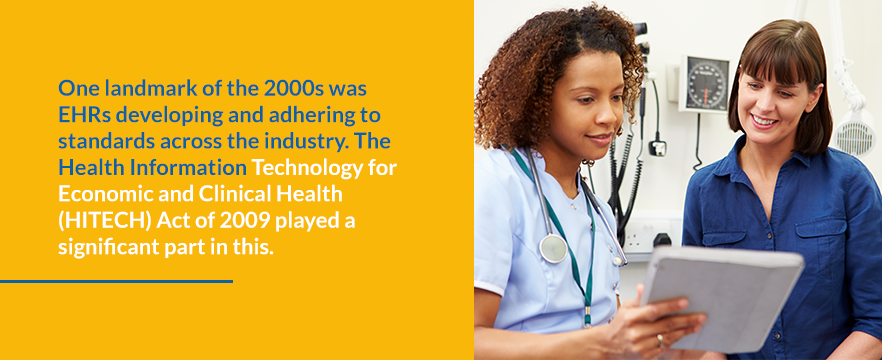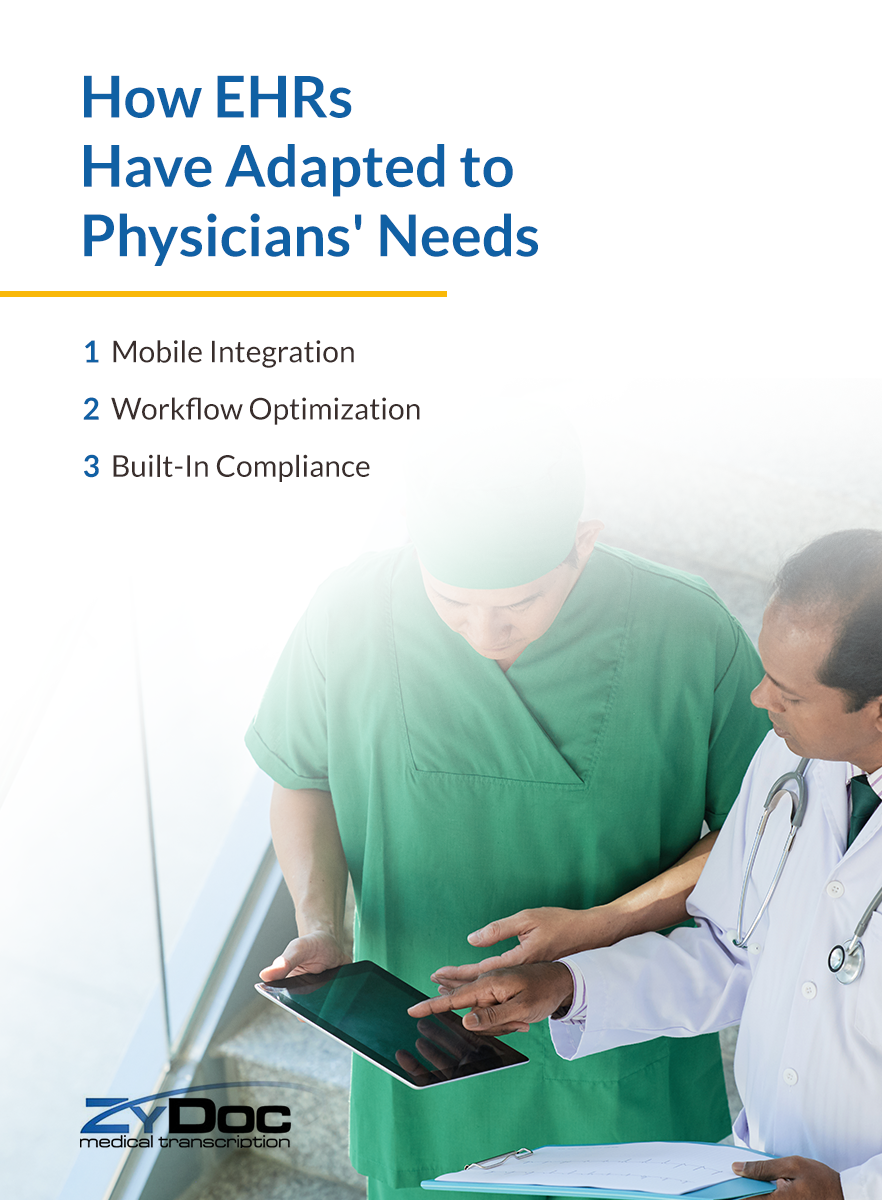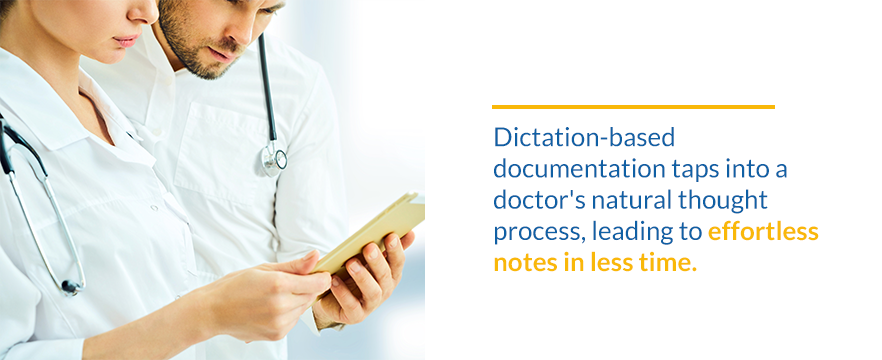The Evolution of EHRs: What Users Need To Know
Dec 19, 2019 | Jonathan Maisel
The electronic health record (EHR) is one of the most significant advances in medical history, affecting the coordination and delivery of care. Despite the fact that EHRs, as we know them today, have only developed in the last few decades, it’s difficult to imagine what modern patient care would be like without them. As a replacement for paper record-keeping, EHRs have significant benefits for both patients and providers.
The EHRs we have today are the culmination of relentless innovation and refinement, and they are developing new functionalities all the time. Understanding the EHR history and timeline is key to making it work most effectively for an organization, and gaining insight into the future of this indispensable tool.
Why Were Electronic Health Records Created?
The concept of the EHR has gone through several iterations over time. The history of electronic health records began in the 1960s, when Dr. Lawrence Weed sowed the seeds of EHRs with the development of problem-oriented medical records (POMR). At the time, the physician took down medical records in any format they chose, without any underlying structural template tying each patient record — or even each appointment — together. Dr. Weed noted this unstructured approach was leading to gaps in information that could have dire consequences for patients. His POMR structure had five components.
- The database:This database consists of the patient’s complete medical history, and expands as information gets added.
- A complete problem list:The physician compiles a list of each issue the patient needs to have managed or resolved.
- Planning:The physician plans what to do about each issue through a diagnostic plan, a therapeutic plan and an education plan for the patient.
- Progress notes:Doctors can make these daily, or at least after each appointment.
- Discharge notes:These notes emphasize any final, unresolved issues and document every step taken in treatment.
This note-taking structure is exceptionally robust and detailed. It is quite similar to the process clinicians follow with EHRs, but had the burden of providers having to hand-write notes at the time of its invention.
The First EHRs
The first example of an EHR we would recognize today came about in 1972. In Indianapolis, researchers at the Regenstrief Institute developed a solution that addressed effective database design and the extreme difficulty of connecting disparate health care organizations in a single record-tracking and dissemination system.
The researchers had zeroed in on the fact that as patients moved from provider to provider, they were leaving incomplete trails of their medical information. For instance, someone might tell their primary care physician a symptom or condition of note that the person’s behavioral health specialist would never be aware of, easily leading to potentially serious errors like misdiagnosis.
The team at Regenstrief collaborated with computer science experts to create completely new code based on the new principles underpinning database structure. Due to the novelty of the system and its astronomical associated costs, the program unfortunately never saw the light of day as a widespread technology.
Instead, the Veterans Administration pushed EHRs into the public eye by implementing one at the same time as the Regenstrief system came out. The Veterans Health Information System and Technology Architecture remains in use and updated even today.
How EHRs Have Changed Over Time
Without the widespread use of the internet, advances in EHR technology remained dormant for the next 20 years or so. As multiple industries began to adopt automation, health care needed a major breakthrough to usher in the era of modern EHRs. The push finally came from a book titled “The Computer-Based Patient Record: An Essential Technology for Health Care.” The work addressed the multitude of challenges providers, administrators and vendors of the technology would face in the implementation of EHRs, paving the way for solutions to these problems.
Up to the publication of the book, most people thought of EHRs as a straightforward substitution for paper records. The new school of thought was that this technology could become actively assistive to clinicians in actually assisting with making decisions and improving the quality of care. At the time, advances in processing power and the development of the cloud finally made EHRs significantly more affordable for practices of all sizes.
The ’90s were a decade of impressive proliferation in the history of EHRs, as multiple vendors raced to make their mark in this emerging market. Recognizing the immense implications of EHRs for patient privacy though, the federal government introduced the Health Insurance Portability and Accountability Act (HIPAA) in 1996 to ensure the protection of patient information extended to newly digitized records.

The Standardization of EHRs
One landmark event of the 2000s was EHRs developing and adhering to standards across the industry. The Health Information Technology for Economic and Clinical Health (HITECH) Act of 2009 played a significant part in this, by offering financial incentives to eligible providers who adopted an EHR and could demonstrate its “meaningful use” in improving the quality of patient care.
One of the crucial requirements for receiving incentives was – and still is – the use of a certified EHR. The Office of the National Coordinator for Health Information Technology certifies EHRs, and third parties test them to ensure they meet the requirements of meaningful use. This stipulation forced EHR vendors to produce systems with a certain amount of security features and the ability to communicate with other platforms, leading to an even greater standardization among the litany of different products.
The incentive program introduced by HITECH had a significant impact on EHR adoption. In 2004, just over 20% of office-based physicians had an EHR system, while nearly 86% had adopted an EHR by 2017.
Current Incentives for EHRs
In its current state, the EHR has become more advanced than ever. However, getting clinicians to notice and take advantage of all of these benefits is not always easy. While the first goal of the HITECH Act was to increase EHR adoption, its secondary objective was to improve interoperability between different EHR systems. Interoperability refers to the ability of different types of EHR systems to interact with each other to improve care coordination.
In 2015, the Medicare Access and CHIP Reauthorization Act established a new incentive program that replaced meaningful use. The Merit-Based Incentive Payment System (MIPS) offers participants incentives based on points they earn in four categories:
- Cost of care
- Quality of care
- Improvement activities
- Promoting interoperability
While health care providers can choose to use an EHR for reporting in all four categories, its usage is a required element if a provider wants to earn any points for the “promoting interoperability” category. Providers can show they meet the requirements by using their EHR for:
- Electronic prescribing
- Verification of opioid treatment agreement
- Sending and receiving data from health information exchanges
- Providing patients electronic access to their health data
Providers can also earn points by reporting to at least two different public health agencies on:
- Immunizations
- Electronic cases
- Clinical data
- Syndromic surveillance
The focus on interoperability and the exchange of information between providers has resulted in the best EHRs offering even more advanced services to stay ahead of constantly-changing regulations.

How EHRs Have Adapted to Physicians’ Needs
We can trace the historical resistance to EHR adoption to one strong issue: EHRs have not always taken physicians’ actual needs into account. In the early days, many physicians were dealing with systems developed by vendors without real experience in the medical field, which were cumbersome and tedious to operate. Today, physicians are concerned that the primary aim of EHR technology is to meet the requirements of insurance payers and incentive programs, instead of being designed to make clinicians’ jobs easier.
While there are still legitimate problems with EHRs, the benefits are undeniable, and many EHR systems have now taken physician concerns into account. Three of the ways the evolution of medical records has adapted to physician needs in recent years has included:
1. Mobile Integration
One of the traditional issues with EHRs was that doctors felt shackled to their computers and distanced from patients. With the introduction of mobile apps connected to EHRs, doctors can now use them in different ways. For example, a physician could pull up test results to show to a patient at their bedside, or enter prescription orders as they move from one exam room to the next. Mobile integration offers flexibility that many physicians believe is missing from EHRs.
2. Workflow Optimization
Older EHRs provided an inflexible interface that treated digital records as nothing but a copy of paper records. Today’s EHRs now seek to help clinicians actually improve workflow by minimizing the burden of administrative tasks like patient scheduling and lab ordering. A good EHR minimizes the typing, clicking and overall steps involved in moving patients through the care system.
3. Built-In Compliance
Another effect of the HITECH Act was to bolster HIPAA by increasing penalties for HIPAA violations and extending the need for compliance to business associates of HIPAA-covered entities. As a result, it’s now more important than ever to maintain compliance to qualify for incentives and avoid penalties, and EHR vendors today recognize this. The best EHRs come with a suite of security features that keep patient data safe.
While doctors still need to ensure they are using a compliant EHR correctly, specific features like authorized access controls and audit logs make it much harder for a malicious actor to cause a data breach.

Medical Transcription With EHR Integration
Despite the many ways in which EHRs have evolved over time, there is still one component that causes bottlenecks in the workflow and contributes to sky-high rates of physician burnout. Documentation and clinical notes are the most time-consuming part of working with an EHR, even though the more comprehensive note-taking results in better quality records and better decisions made about patient care.
A recent Harris Poll conducted on behalf of Stanford Medicine asked 500 primary care physicians about EHRs, and the results show there are still significant gaps in EHR capability when it comes to documentation. While 63% of physicians believe EHRs have improved care in general, 74% say their EHR has in fact increased their total number of working hours per day, and 71% agree that EHRs have significantly contributed to burnout. That is primarily because working with the EHR takes up 62% of the time doctors have with each patient.
Medical transcription with EHR integration provides an elegant solution to the problem of documentation within electronic health records. It allows doctors to dictate their notes into a smartphone app, digital recorder or telephone and have those notes transcribed. The benefits of medical transcription for physicians are significant, and include the three following advantages.
1. Substantial Time Savings
As the Stanford Medicine poll revealed, doctors spend more time staring at their computer screen than interacting directly with patients. When a doctor can dictate notes as they conduct the appointment, they don’t need to waste time finding the right template, clicking on all the appropriate components and typing out their thoughts. Dictation-based documentation taps into a doctor’s natural thought process, leading to effortless notes in less time.
2. Maximum Accuracy
Dictation using transcriptionist review is still the most accurate way to capture clinical documentation. When doctors manually enter information or use speech recognition software alone, the margin for error is worrying. Documentation created through speech recognition without review has a 7.4% error rate — more than enough to make a difference in a life-or-death situation. However, documentation generated with speech recognition that then receives review by a trained transcriptionist has an error rate of only 0.4 percent.
In addition to potentially saving lives, this degree of accuracy helps ensure that providers receive maximum reimbursement from payers through the creation of robust documentation.
3. Ease of Use
Doctors using an EHR have already put significant time and energy toward mastering the new interface and conquering the learning curve. They don’t want to take more time out of their busy schedules to add another new technology to their repertoire, and they shouldn’t have to. For instance, spending time training speech recognition software is time-consuming and tedious, and with the error rate this technology has, doctors may not feel it’s worth it.
Medical transcription, however, is highly intuitive and requires no training. A physician only has to know how to start dictating, stop and send the recording. Medical transcription with EHR integration even inserts the finished documentation into the EHR with no action needed on behalf of the physician. As such, there is simply no less labor-intensive method of reducing physicians’ documentation burden.

Let ZyDoc Help You Embrace Your EHR
Doctors in a practice of any size struggle with the requirements of documentation in EHRs. To earn incentives and avoid penalties, organizations must use EHRs to their full potential, but doing so places an undue burden on doctors that can quickly lead to burnout and missing the goal of improved care. ZyDoc is an award-winning, U.S. based medical transcription service founded by a physician that understands the real-world needs of practicing physicians, and offers a way to make documentation easy and seamless as we approach the future of electronic health records.
Our service is 61% faster than traditional typing and clicking, and 38% more accurate than speech recognition alone. All this comes with a turnaround time of just two hours for 90% of dictated jobs, and with our EHR integration service, your notes will be where you need them, when you need them— automatically.
If you’re ready to experience the freedom and ease of medical transcription with EHR integration, call 1-800-546-5633 to start you 14-day free trial or view our plans and pricing and see what level of service is right for your organization.
